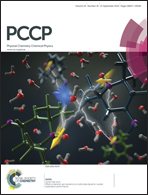Electrokinetic desalination using honeycomb carbon nanotubes (HC-CNTs): a conceptual study by molecular simulation
Abstract
A new concept of electrokinetic desalination using a CNT honeycomb is presented through molecular dynamics simulation. The preferential translocation of ions towards the outlets near two electrodes was realized by applying an electric field perpendicular to bulk fluid flow in a CNT network, which, in the meantime, generated deionized water flux discharged from the central outlets. The effects of the major factors such as electric field strength, numbers of separation units, diameter of CNT, and ion concentration on the desalination were examined. It was shown that over 95% salt rejection and around 50% fresh water recovery were achieved by the presented module by applying an electric field of 0.8 V nm−1. CNT diameter, which is critical to ion rejection without the electric field, had a marginal effect on the desalination of this new module when a strong electric field was applied. The desalination was also not sensitive to ion concentration, indicating its excellent workability for a wide range of water salinity, e.g. from brackish water to seawater. A potential of mean force profile revealed a free energy barrier as large as 2.0–6.0 kcal mol−1 for ions to move opposite to the implemented electrical force. The simulation confirmed the high potential of the CNT honeycomb in water desalination.


 Please wait while we load your content...
Please wait while we load your content...